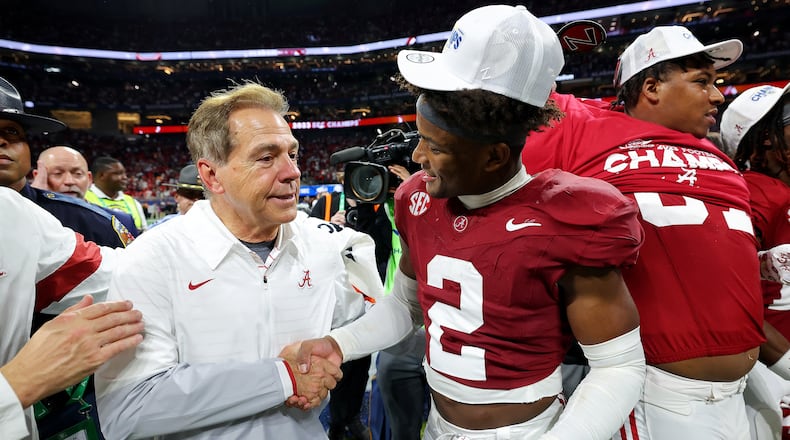This is the second in a three-part series on the transfer portal, which opens on Tuesday.
ATHENS — Another college football season is about to kick off, but it has nothing to do with scoring touchdowns.
The winners and losers of the spring football portal season — Tuesday through April 30 — will be determined by roster enhancement and retainment as players enter into what amounts as a free agency period.
The Big Ten and SEC schools figure to benefit the most in portal action due to the available resources they have, much of it anchored in lucrative television contracts.
The SEC stands at a slight disadvantage, however, because of a league rule denying immediate eligibility to players who transfer within the conference in the spring. SEC players who transferred in the fall/winter portal window (Dec. 4-Jan. 2) are allowed immediate eligibility within the league.
SEC member Ole Miss was the big winner of that earlier portal window, when Coach Lane Kiffin took in 15 transfer players. Kiffin, who had 28 transfers last season, has been among the most vocal critics of the current process in place.
“What I kind of call the disaster we’re in,” Kiffin said at the SEC spring meetings last May when asked about transfer portal rules and how NIL dealings affect players’ choices. “Whatever programs have the most aggressive boosters with the most money are going to get the players.”
To Kiffin’s point, the richest college programs are essentially a Who’s Who of annual football championship contenders and figure to benefit the most when the portal opens again on Tuesday.
Ohio State ($251.6 million, per USA Today) was the top revenue-producing athletic department in 2023, followed by
• Texas ($239.9 million)
• Alabama ($214.3 million)
• Michigan ($210.6 million)
• Georgia ($203.1 million).
Those schools — along with every other in FBS ranks — also have collectives in place to help provide funding for the schools to be competitive for players coming out of high school or looking to transfer from another program.
And, while some programs might feel secure enough about their returning talent to not seek an incoming transfer through the portal, there is still the issue of retaining current players.
“I thought we could have a hell of a team next year,” Former Alabama coach Nick Saban said in a recent ESPN interview. “And then maybe 70 or 80 percent of the players you talk to, all they want to know is two things: What assurances do I have that I’m going to play because they’re thinking about transferring, and how much are you going to pay me?”
Business is business, as two University of Georgia players discussed last December during their paid performances on an NIL-sponsored program.
“Always bet on yourself, always go where you feel you have the best opportunity,” Georgia All-American Malaki Starks said when asked what advice he would give to recruits.
Miles Thornton, Starks’ co-host, said players’ understand and support teammates looking for the best deals.
“You’ve got to understand, this is a business, this is cut-throat,” Thornton said. “In the locker room we get excited when somebody gets an opportunity to go showcase their talent somewhere else.”
A lack of transparency can make for complicated negotiations, however, as LSU coach Brian Kelly pointed out after joining the league.
“What’s real and what is fiction?” Kelly said during an SEC Spring Meetings event. " A kid could say, ‘I was offered $1.5 million to come to ‘X’ school, you better get on board or you’re not going to get me.”
There were fireworks in the most recent portal season (Dec. 4-Jan. 2) with more than 2,000 players entering their name.
Some high-profile SEC players were among the most sought-after. Per 247Sports transfer rankings, five of the top 10-ranked portal players left the league.
Caleb Downs, the No. 1-ranked player in the portal and former national freshman of the year award winner from Mill Creek High School in Gwinnett County, is the was the most high-profile departee.
The former Alabama starting safety chose Ohio State over Georgia in a well-documented recruiting battle.
The Buckeyes took three of the SEC’s top players via the portal, having also added former SEC rushing champ Quinshon Judkins from Ole Miss and rising Alabama quarterback Julian Sayin, the No. 1-ranked QB in the 2024 signing class. As if that wasn’t enough, former Alabama starting center and Buford star Seth McLaughlin transferred to Ohio State, which also hired former Tide offensive coordinator Bill O’Brien.
“We don’t decide who’s in the portal,” Buckeyes coach Ryan Day told The Athletic. “But when guys are there, we want to upgrade our roster in certain areas.”
And Ohio State, with the top revenue producing athletic program in the nation, has the resources to do just that.
There is no official scoreboard during the NCAA portal seasons — some attrition can be healthy as it clears up scholarships for other talented prospects to be brought on.
But the age old saying that the “rich get richer” certainly applies to the free agency aspect of the NCAA portal season.
Part 1: What the spring window really means for Georgia, SEC
About the Author
Keep Reading
The Latest
Featured


